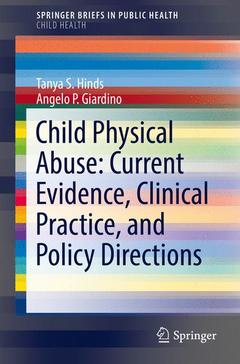Child Physical Abuse: Current Evidence, Clinical Practice, and Policy Directions, 1st ed. 2017 SpringerBriefs in Child Health Series
Auteurs : Hinds Tanya S., Giardino Angelo P.

This eye-opening monograph challenges professionals across disciplines to take a more thorough and focused approach to addressing child physical abuse at the practice and policy levels. Positing child physical abuse as a public health crisis (as opposed to a more vague ?social? one), the authors use empirical findings and clinical insights to advocate for wide-scale reforms in screening, assessment, responses, treatment, and prevention. The book?s social/ecological perspective delves into root causes of physical maltreatment, analyzes the role of family and community risk and support factors, and notes forms of discomfort keeping many professionals from meeting the issue head-on. From there, chapters describe coordinated multidisciplinary efforts for intervention and prevention with the potential to avert all forms of child abuse.
Included in the coverage:
· Adverse childhood experiences (ACEs)
· The non-verbal child: obtaining a history for caregiver(s)
· Clinical perspectives on multidisciplinary collaboration
- Corporal punishment and risk for child physical abuse
- Intimate partner violence (IPV) and risk for child physical abuse
- Evolution of child maltreatment prevention
- Complementary dynamic prevention approach
Enables readers to gain an overview of child physical abuse, which affects at least 200,000 children each year in the USA
Identifies the main approaches to conceptualizing the etiology, presentation, treatment, and prevention of child physical abuse
Summarizes the latest studies related to how best to evaluate and prevent child physical abuse
Equips readers with concepts, models, frameworks, and evidence that help professionals and the lay public in understanding and responding to child physical abuse
Reinforces basic principles in the evaluation and prevention of child physical abuse
Includes supplementary material: sn.pub/extras
Date de parution : 10-2017
Ouvrage de 153 p.
15.5x23.5 cm
Thèmes de Child Physical Abuse: Current Evidence, Clinical... :
Mots-clés :
child abuse; child maltreatment; child victimization; child physical abuse; child homicide; fatal abuse; battered child syndrome; child abuse and neglect; abusive parenting; adverse childhood experiences; child protection; corporal punishment; child fatalities; child abuse prevention; domestic violence; family violence; community health; physical abuse



